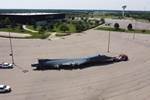NIAR AVET Lab at Wichita State University offers small unmanned aircraft testing
Small unmanned aircraft (sUA) certification capability complies with new FAA AC107-2A sUAS operations over people requirements.

sUA testing capabilities at NIAR AVET. Left depicts a launching device and anthropomorphic test dummy (ATD) setup. The right shows the university’s sUA Impact Launcher with Rigid Seat. Photo Credit: NIAR AVET
The Advanced Virtual Engineering and Test (AVET) Lab at Wichita State University’s National Institute for Aviation Research (NIAR, Kan., U.S.) is said to be well-known for its virtual engineering, numerical modeling methods and aircraft seat testing, but also boasts a small unmanned aircraft (sUA) certification capability. This development retains significance to the composites industry, per the extensive use of composites in unmanned aircraft.
AVET researchers, engineers and technicians are partially responsible for the research that led to new guidance for operating sUA over people in the National Airspace. Section 8.5.2 of FAA Advisory Circular 107-2A states applicants for Title 14 of the Code of Federal Regulations part 107 may use an FAA-accepted method of certification (MOC) developed by a voluntary consensus standards body or other entity, or an FAA-accepted MOC developed independent of the FAA.
Specifically, ASTM F3389-20 meets this requirement. This certification model was partially based on research conducted at NIAR AVET through the FAA’s ASSURE Center of Excellence for UAS. The test is conducted using a launching device and anthropomorphic test dummy (ATD) setup. NIAR AVET can conduct certification testing using ASTM F3389-20 sections 4.3 and 4.4 (methods B and C), and soon-to-be-approved Method D (section 4.5).
According to ASTM, method B uses an instrumented ATD head form and requires the applicant to conduct a series of impact tests using the sUA. Impacts are conducted at the most probable worst-case impact orientation, which is determined through a combination of engineering judgment and experiments. Method B is not appropriate for testing foam fixed-wing sUA due to the increased rigidity of the test setup.
Method C uses an instrumented ATD and requires impacts at multiple energies and three different impact angles. These test results can be compared to automotive injury risk metrics associated with 30% probability of an AIS 3 or greater injury or against defined injury metrics developed and used by the governing Civil Aviation Authority.
Method D uses an instrumented ATD head form and neck and requires the applicant to conduct a series of impact tests using the sUA and a rigid object. The test results of the sUA are compared with the results for rigid object at each orientation with the results of the head injury criterion (HIC15), Peak Acceleration, the Nij Neck Injury criterion and neck compression being the acceptance metrics. The weight limit for these Methods is eight lbf for sUA and up to 55 pound-force tested at parachute speeds for larger sUA.
An additional virtual method is also under review by ASTM. If approved, NIAR reports that it will be one of only a few places in the U.S. capable of conducing this certification test. Learn more about sUA testing available at NIAR AVET at this link.
Related Content
-
Toray, University of Chicago speed up polymer recycling R&D
A jointly developed multi-scale computational predictive technique can accurately predict viscoelasticity from the chemical structures of polymers, ramping up product maturation.
-
Zeiss, Imperial College London summer school enhances materials, sustainability learning
Twenty-four next-generation students attended the Imperial College London this August to advance their scientific knowledge, with workshops, lectures, activities and a composites competition.
-
The Native Lab launches composites course training membership plan
Courses that touch on the fundamentals of composite materials, design, analysis and more are available for individuals and companies alike through TNL’s online platform.
















